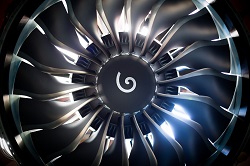More efficient aircraft engines lower running costs and environmental impact
E-BREAK has developed more advanced, lighter aircraft engine components capable of withstanding higher temperatures and pressures. Further maximising the engine’s ability to operate across a range of flying conditions (including take-off, cruising and landing) and in various weather conditions, E-BREAK also improved internal subsystems performance such as sealing systems as well as the accuracy, weight and load capability of engine devices. Better sub-systems for more robust engines with predictive maintenance The drive towards more efficient and reliable engines has resulted in smaller engine cores which run hotter and faster at higher pressure ratios and require less scheduled maintenance. As previous projects had focused on core engine technologies, E-BREAK was set up to address the evolution of engine sub-systems, which have to adapt to the new constraints of core technologies. As the E-BREAK project coordinator Dr Manuel Silva explains, ‘An engine is like a puzzle. If you improve one part, you have to be aware of how that change then affects the other parts. Generically designed supportive systems we call technology enablers, allow you to keep the parts working together, effectively and seamlessly and across a broad range of aero-engines.’ Examples of technology enablers are oil and air cooling systems for temperature control. While an aircraft has to use most of its air intake mass flow to achieve thrust, it also relies on air to keep the oil from overheating, which could damage the engine. The E-BREAK team developed better performing sealing technologies for the oil and air systems, to further enhance overall engine performance under extremely high pressures. E-BREAK has also accomplished other key innovations. For example, the improvement of abradable coatings between engine components that rub together and so are prone to degradation, such as the material between the blade tips and their casing. The project also achieved a major breakthrough in reducing engine weight by considering lighter turbine blades, constructed using the new titanium aluminoide intermetallic alloy. While considered a very promising alloy, it has been difficult to process. The project was able to optimise the blade’s design and manufacture after testing the alloy’s properties and performance during flight. Another important E-BREAK contribution is its health monitoring system, which anticipates engine component deterioration. The system uses sensors and advanced algorithms to pin-point the location of a problem. Previously, as the location of a fault was often unknown, engineers replaced multiple parts as a precaution. E-BREAK’s system reduces the amount of time aircraft are grounded for repairs, lowering overall maintenance costs and loss of revenue through reduced flying time. Crucially, it also increases overall safety through its accurate identification of problems. Working towards targets The Advisory Council for Aeronautics Research in Europe (ACARE) has set the goal of a 50 % reduction per passenger kilometre of CO2 emissions, with NOX emissions to be reduced by 80 % and a decrease by 15 to 20 % of SFC, an indicator of jet engine fuel efficiency. The E-BREAK project, is part of a wider EU-funded initiative to lower emissions by concentrating on improving aircraft engines which includes the LEMCOTEC, NEWAC, DREAM, VITAL and ENOVAL projects. Together, these projects will reduce aviation CO2 emissions by between 21 and 32 % and lower NOX emissions by as much as 65 to 70 %, depending on engine size. As Dr Silva concludes, ‘E-BREAK’s results offer crucial steps towards ensuring the compatibility of a new generation of engine sub-systems with the increased constraints in temperature, pressure and mass of future engines, necessary to meet ACARE targets. Through these efforts, the aviation industry and the people it serves can look forward to even more efficient, reliable and safer air travel that is also kinder to planet Earth.
Keywords
E-BREAK, predictive maintenance, core engine technologies, technology enablers, oil and air cooling systems, abradable coatings, titanium aluminoide, intermetallic alloy







